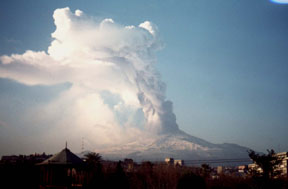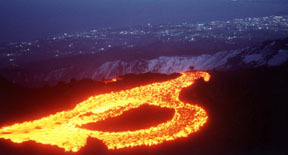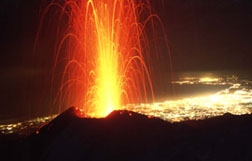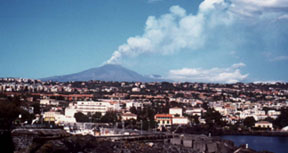geotimesheader
Geophenomena
Eruptions
of Mount Etna, Sicily
Link to the Web
edition timeline showing Etna's eruptions since 1995.
by Boris Behncke
| For 15 months, from December 1991 to March 1993,
Mount Etna in Sicily purged lava from its side, threatening the town of
Zafferana. About 230 million cubic meters of lava poured from a fissure
on the southeast side of the volcano. This was the latest in a series of
13 flank eruptions at the volcano since 1971 and it was the most voluminous
and longest-lasting flank eruption of the last 300 years.
Seven years have passed now and it seems that
the people living around Etna have been getting used to the absence of
eruptions from the volcano’s sides. But, the frequent spectacular summit
eruptions since 1995 have served as a reminder that Etna is there and it
is active. |
1. |
| During the last five years, all four summit craters
have been the sites of highly variable and dramatic eruptions that have
continued through March 2000.
From November 1995 to June 1996, Etna’s Bocca
Nuova crater activity remained at relatively low levels, while the Northeast
Crater became quite energetic and produced 10 violent eruptive episodes.
In early November 1996, Etna’s Southeast Crater
began low-level Strombolian activity, characterized by small explosions
ejecting fragments of incandescent lava, and by extrusion of small volumes
of basaltic lava onto the crater floor. |
2.
1. The Southeast Crater cone fractured
from the summit to the
base
during this explosion on Feb. 4, 1999. Afterwards, lava
poured
from new vents for seven months. 2.
Lava flows on the
Southeast
flank of Etna on March 11, 1999.
3. The Southeast
Crater
on Aug. 5, 1997. 4.
Bocca Nuova explodes on Oct. 22,
1999.
Photos courtesy of Boris Behncke. |
| Between July and December 1997, the activity
extended to the Voragine, a summit crater that formed in 1945 and is also
known as “the Chasm.” On July 22, 1998 the most violent explosion of the
period produced an eruption column 10 kilometers high. Extensive lapilli
and ash fell onto the east and southeast sides, while the first lava flow
from the area since 1964 advanced onto the northwest side of the main summit
cone.
The crater was largely filled in by the end of
1998, making it possible to walk across its floor to a new vantage point
of Bocca Nuova. In less than a year the viewing area would disappear. |
3. |
s
| After a few months of relatively low levels of
activity, on Jan. 26, 2000, the Southeast Crater began initiating a series
of violent eruptive episodes.
On Feb. 15, lava fountains rose up to 800 meters
from the crater. Ash and lapilli frequently fell in villages and towns
around the volcano and fine ash was at times carried up to 50 kilometers
away. As of late March 2000, more than 40 such episodes have occurred,
an unprecedented event in the recent eruptive history of Etna. |
4. |
Public response and hazards
The activity at the summit craters is attracting
tourists and scientists from all over the world. In 1999, about one million
people visited the summit area on organized excursions with Etna mountain
guides. However, many visitors who go to the summit craters without any
guides expose themselves to great risk.
Half of the time the weather is unstable, preventing
visibility of the eruptive activity and making it easy for visitors to
get lost. Even for experts, it is difficult to evaluate when the summit
activity is about to become dangerous. It is pure coincidence that no tragic
accidents have happened in the past few years.
The summer season of 2000 will see a new surge
of tourists toward Etna, but they will need a new viewing area. Increased
lava production since early March led to the emplacement of large lava
flows around the Southeast Crater cone. Some of these flows reached an
isolated mountain hut named Torre del Filosofo that had been built in the
late 1960s. The lava encircled the concrete building on two sides, piling
up nearly to its roof, and burned a small wooden shack that was used by
the mountain guides during the summer season as a safe place where tourists
could rest and buy souvenirs.
Significance of recent
eruptions
During the almost five years of summit activity
initiated in the summer of 1995, unusual simultaneous eruptive activity
from two or more summit craters was quite common. Etna produced some 80
to 90 million cubic meters (comparable to the volume of some 15,000 Olympic
swimming pools) of lava and about 20 million cubic meters of pyroclastics.
This is much less than the volume of the last flank eruption, but about
80 percent of the lava was produced in two large events in 1999: the long-lived
effusive activity near the Southeast Crater and lava overflows from the
Bocca Nuova. The effusion rates during these two events were close to those
of a “normal” flank eruption of Etna.
Does this mean that Etna has become more active?
It seems it has. No summit eruption of the volcano has produced similar
volumes in such a short period during the past centuries. Since 1865, four
periods of long-lived summit eruptions are known, and almost all began
after a particularly voluminous flank eruption.
Etna’s eruptive behavior, for at least the last
150 years, falls in a clearly cyclical pattern. Each eruptive cycle consists
of an initial period of repose of several years, followed by long-lived
summit eruptions (such as those initiated in 1995 and continuing to the
present day) and culminating in a series of flank eruptions occurring in
rapid succession. Etna may thus continue producing summit eruptions for
another five to 10 years before a flank eruption attacks again.
Link to a timeline
of Mount Etna's eruptions since 1995.
Behncke is a volcanologist
from the Dipartimento di Scienze Geologiche (Sezione di Geologia e Geofisica)
at the University of Catania, Italy. More information on Etna can be found
at www.geo.mtu.edu/~boris/ETNA.html.
To comment, send Email to: geotimes@agiweb.org.




